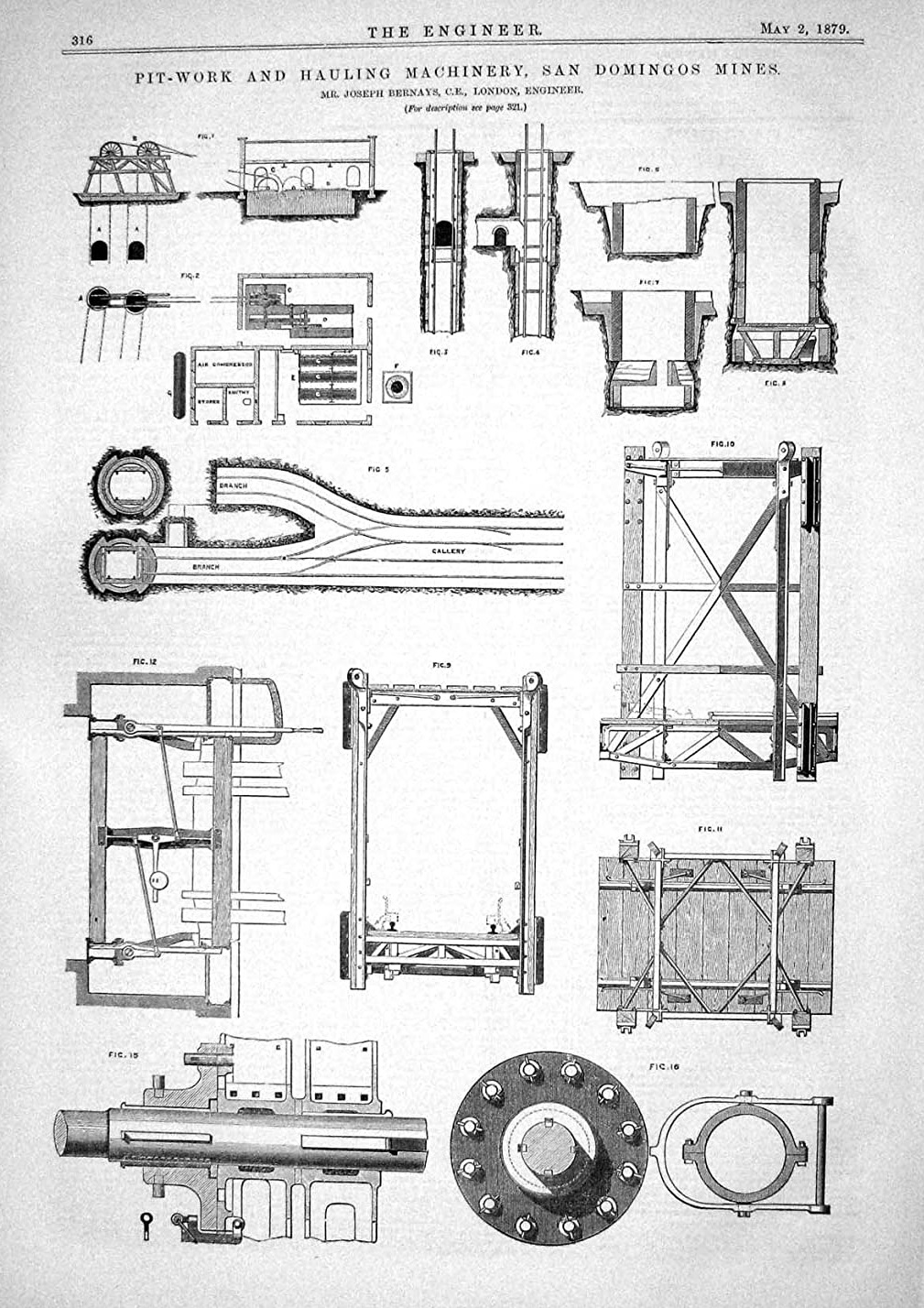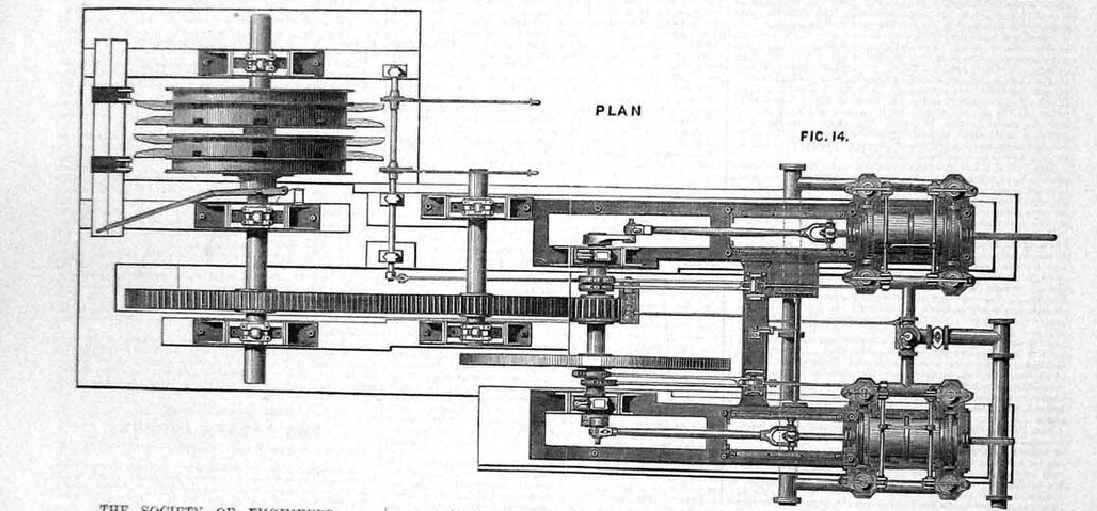Biografia
Engenheiro civil residente que foi no nº 96 Newgate Street, Londres.
JOSEPH BERNAYS morreu em Londres em 24 de Dezembro de 1906, aos 71 anos.
De origem alemã, nascido em Mainz em 26 de maio de 1835 tendo-se formado na Escola Politécnica de Karlsruhe.
Em 1868, estabelece-se por conta própria. Foi nomeado Engenheiro Consultor dos Srs. Mason e Barry, Limited, proprietários de minas de cobre em Portugal, supervisionando para os mesmos a abertura de novos poços de extração, a montagem de máquinas de bombear, locomotivas e a construção de reservatórios, aterros, além de projectar extensas obras para a fabricação de ácido sulfúrico em larga escala em Rainham, na região de Essex.
THE SOCIETY OF ENGINEERS
MARCH 3, 1879.
MR. ROBERT PAULSON SPICE, PRESIDENT, IN THE CHAIR.
THE following paper on "The New Pits and Hauling Machinery for the San Domingos Mines in Portugal," was read by Mr. Joseph Bernays, vice-president: The San Domingos iron pyrites mines in Portugal form one of a group of three, from which the principal supply of ore is obtained which is sent from the southern Spanish peninsula to this country. These mines are in close contiguity to the small streamlet Chanza, about twelve miles above its embouchure with the Guadiana river, which it joins at a place called Pomarao, about fifty miles from the sea.
the same group, and competing with each other, are the "Rio Tinto "and the "Tharsis" mines, both situated over the border, in Spain. About twenty years ago the San Domingos mines were in the hands of a Spanish exploring company, who had no real intention of working them. They had confined themselves to clearing out the old Roman adit and a few of the old Roman shafts, and had broken a few hundred tons of ore, no road whatever between the site of the mines and any possible shipping port on the Guadiana river, twelve miles distant, Pomarao itself being only the name of a locality without either buildings or inhabitants. The buildings at the mine at that time consisted of a rough house, formed out of an old hermitage by the addition of a small carpenter's shop and smithy for sharpening miners' tools, and some mud and stone huts, built for themselves out of the materials at hand by the few miners and workpeople employed. The scene, however, soon changed under the energetic and spirited management of Mr. James Mason, of Eynsham Hall, Oxon, who at that time became the proprietor of the mines, ably assisted in London by his representative and relative, Mr. Francis Tress Barry, of Clewer, who has since joined Mr. Mason in one firm. After having carefully studied the country and the river, Mr. Mason fixed upon Pomarao as the shipping port, where proper loading stages were erected, and where vessels and steamers of considerable tonnage can lie safely at anchor. The right of way was next acquired for a road from the mines to the port, and a road was constructed for mules and horses, which formed the first means of communication. Then came the widening and improving the road suitable for mule carts for the carriage of the first ore for shipment, and also for bringing up building materials to the mine. Subsequently new ground was taken in to allow of easier gradients and curves, and a rail-road was laid down of 3ft. 6in. gauge, which was first worked by mules, but finally taken possession of by the iron horse some time in 1861. The work at the mines themselves was, however, during
that interval proceeding rapidly. The mass of ore, which originally was reached by means of shallow levels and galleries, was now relieved of its smperincumbent weight of earth and
stones, and laid entirely bare to a large extent for open workings, the shallow levels and galleries were extended in all directions, new and deeper levels were attacked, hauling and pumping engines and boilers, with the necessary repairing shops, were erected, and the whole assumed the appearance and importance of a large and valuable industry. In busy times more than two thousaud people are now emmployed in various parts of the works;
there are neat streets of cottages for the miners, rows of good houses, with gardens, for the managers and employés, a central office, chapel, schools, &c., and the whole is carried on in a systematic and comprehensive manner under the liberal direction of Messrs. Mason and Barry, assisted by able and competent resident managers and heads of departments.
In 1872, when the author first became acquainted with the mines, the ore was raised to the surface of the ground through three tunnels, one of which, leading to the upper levels, was
worked by locomotives direct, the others by means of fixed hauling engines and wire ropes.
As the trade increased and the quality of the ore became better known, however, it was found that it would be desirable to attack a still lower level of the ore, and to have a separate outlet for the same with connections, if necessary, to the other levels. The question then arose, and was discussed at some length, as to the best method for accomplishing that object. Various methods were submitted. One plan suggested, was to drive another tunnel, with a gradient similar to the steeper one now in use, viz., on an incline of 3 or 4 to 1.
The tunnel to commence near the mouths of the existing tunnels, and to be worked by means of fixed hauling machinery erected in the vicinity of the present engines, the rails to be laid in such a way as to allow the empty descending trucks to partly counter-balance those which were brought to the surface filled. Another plan proposed was to drive a tunnel of less inclination and greater length outside of the principal mass of ore, and parallel to its main direetion, touching the ore at the lowest practicable level by means of a curve, and brought in contact with the higher levels by means of special curved galleries. This tunnel could have been driven at a gradient of 1 in 20 or thereabouts, and could thus have been easily worked by our ordinary locomotives, which are employed on a line the heaviest incline on which is at the rate of 1 in 19. The next plan, that recommended by
the author, was to sink vertical shafts outside of the principal mass down to the deepest level, with suitable landings at any of the higher levels with which it might be desirable to connect the system. Cages and winding engines to be used similar to the plan generally adopted, the ascending and descending cages balancing each other. Yet another plan was examined, viz., the use of inclined shafts or pits, with cages on which the trucks
would be placed and pulled up by means of winding engines, the empties balancing the full trucks, as in the previous plan. Each of these propositions having been carefully discussed between
the proprietors, the resident officers, and the author as the consulting engineer, and an estimate of the probable cost of each arrangement having been made, with due consideration of the local difficulties in each case, the author's scheme of the vertical
pits was finally approved of and adopted, and is now in course of execution. The next point to be settled was the size and shape of these shafts, and here several features had to be taken into consideration, First, as to the size. It bas been the custom at the mine, since a railway was first laid down, to have all the lines, both above and below ground, of the same gauge, and all working trucks of approximately the same size, in order to avoid waste and loss in loading and unloading the ore. Thus any truck loaded at any part or level of the mine can by one or other of the appliances already mentioned be taken to the surface and despatched on the railway journey down to the shipping place without the expenditure of any further labour.
The writer need not dwell upon the particular advantages of that arrangement, as the saving in time, labour, expense, and wear and tear wherever such a system can be carried through, will be evident to everyone. When, therefore, the question arose as to what gauge of rails and what size of trucks to employ in the new levels, it was speedily agreed to adhere to the gauges and sizes in vogue, although the new and lower levels would for many years to come be carried on quite independently of the rest. The gauge of rails is 3ft. 6in.
The trucks in use cary each about 4 1/2 tons of ore. Their bodies are of iron, about 6ft. long by 4ft. wide by 2ft, deep, with one end made to open for the discharge of the ore.The under-frames are of oak, carried on four wheels, each 2ft, diameter on
tread, and fitted with steel tires. There are no bearing springs nor spring buflers, the axle- boxes are simply bolted underneath the frames, with a thick piece of vulcanised india-rubber between, and the drawbars take hold of the underframes through the same
medium. The total length over the ends of the sole-plates, which form dummy buffers, is 8ft. There are at the mine also a few varieties of side-tipping trucks, holding 5, 7, and 10 tons each respeetively, but as these are not used underground, and are required only for special local purposes, they need not at present be further considered. On a future occasion the author may be able to deseribe a new tipping arrangement which he has applied to some of the heavier of those side tipping trucks, and which appears to work satisfactorily. The size of the trucks being given as just described, determined of course the size of the cages for raising the same, and this settled the size of the shafts, Next the question of their shape had to be considered. The experience of the mines having been principally gained from tunnelling and shallow pits, and these having always been imade secure by heavy timbering, it will appear natural that a shaft should have been demanded in the first instance of rectangular section, of such size as to admit of the two cages side by side with a timber partition between them, and the whole heavily timbered.
(...)




